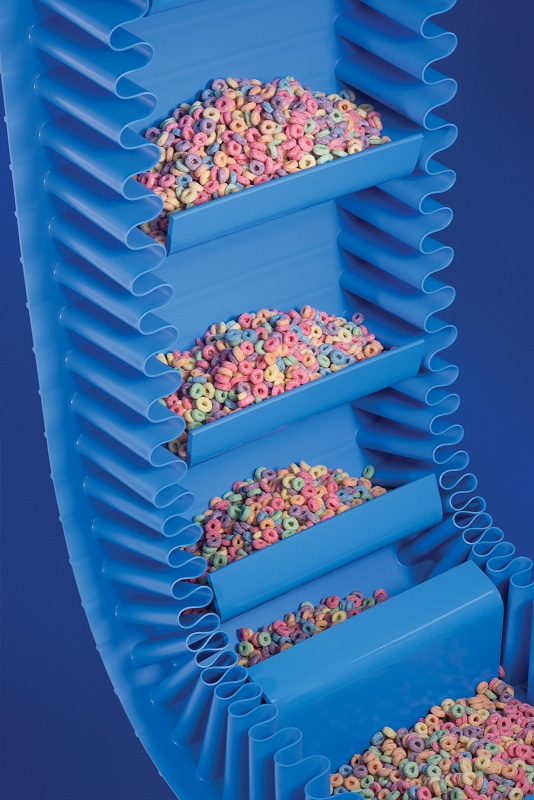3 Essential Factors to Consider for Your Next Food Grade Conveyor
February 12, 2020

Let’s be honest: When it comes to food processing, the stakes are high. All it takes is one contamination incident to wreak havoc on your bottom line, reputation, and business. In fact, according to a study published by the Food Marketing Institute and Grocery Manufacturers Association, the direct costs of a recall to a food company averages around $10 million (and this is in addition to brand damage and lost sales).
With the FDA’s Food Safety Modernization Act (FSMA) enacted by President Obama in 2011, the focus has shifted from food contamination response to prevention. This not only broadens the FDA’s authority to regulate food processing, but places greater ownership on manufacturers to keep contamination at bay.
It doesn’t stop there. Food traceability is also gaining broader public awareness and support. According to the International Food Informational Council Foundation (IFICF) — which identified traceability as a top food trend for 2019 — “Consumers want to know how their food is produced.” Thanks to technological advancements, like blockchain-based food traceability, inspections have not only become cheaper but more accurate.
Click here for information about the upcoming International Powder & Bulk Solids Conference/Exhibition
So, where does that leave you? As a food manufacturer, you’re more accountable than ever for your product. Keeping up with new mandates, standards, and regulations from the FDA — not to mention the U.S. Department of Agriculture (USDA), Baking Industry Safety Standards Committee (BISSC), 3A-SSI (Dairy 3A), and others — can certainly be overwhelming, especially if you need to replace your equipment.
Fortunately, if you know what to look for, you can find a food grade conveyor that meets the most stringent hygienic standards, without compromising productivity. The following guide details which factors to consider when making your purchase and will help you select the best possible fit for your production line.
Cleanability
It’s no secret that processing production lines are subjected to rigorous hygienic requirements, so it’s important that your conveyor is up to snuff. Investing in equipment that’s quick and easy to clean will help you maintain the antiseptic conditions required by regulators, as well as avoid potentially disastrous setbacks.
To start, choose a washdown-rated conveyor capable of withstanding the high pressures and temperatures associated with water, steam, and chemical cleaning. Drive motors and gearboxes should also be washdown rated and outfitted with seals, which negate the need for removing peripheral equipment. Features such as quick-release clamps and fasteners make it possible to disassemble your conveyor for cleaning, without having to use any tools. This helps further minimize downtime and facilitates faster equipment turnaround.
Where possible, opt for a clean-in-place (CIP) washdown system. While the clean-out-of-place (COP) system affords more flexibility if you want to reconfigure your process in the future, it also costs more time and lost throughput to relocate the conveyor to a remote cleaning station. As a matter of fact, CIP systems can reduce the downtime required for cleaning by as much as 50 to 75 percent!
Design and Construction
There’s a good reason why so many food grade conveyors are constructed from stainless steel: It’s more resistant to microbial growth and corrosion than other variations. But it’s not enough to simply buy a stainless steel conveyor and call it a day, especially when there’s food involved.
Sanitation needs to be factored into every aspect of the conveyor design and construction. This is where simple design reigns supreme, since fewer parts make it easier to take the conveyor apart for cleaning. The design should also reduce the number of entrapment points — such as ledges — where residue can accumulate and degrade. Selecting a conveyor with rounded frames and minimal horizontal space can help keep the residue at bay.
Of course, one of the most important elements of sanitary design is the belt itself, since it’s going to have direct contact with your product. Belts should be constructed from antimicrobial material that inhibits the growth of pathogens, like FDA-approved polyurethane. You’ll also need to consider how easily the belt can be cleaned and whether it can support temperature extremes. Side walls are another useful feature, since they help contain product and reduce spillage — as well as the need for excessive cleanup.
Longevity
Quality equipment sourced from reliable manufacturers can last 20 years. A little forethought during the buying process, however, helps to increase the lifespan of your conveyor even further. The key lies in selecting features that enable you to reduce the operating speed, since faster units are typically subjected to greater wear and tear.
One way to do this is by investing in a maximum width belt. Don’t be deterred by the upfront costs. While it might set you back more than smaller alternatives, a wide belt offers reserve for future capacity increases, without requiring the unit to run at a greater speed. A smaller belt, by comparison, will need to run at a faster rate in order to meet increased demands for throughput in the future.
Numerous belt enhancements are available to further improve a conveyor’s capabilities. Increasing the number of belt cleats, for instance, makes it possible for more product to be carried through the production line, without relying on speed. This can further improve the longevity of your equipment.
Back to You
There’s a lot to think about when sourcing a food-grade conveyor. With a seemingly endless supply of options available, it’s easy to get overwhelmed. Mistakes are more costly now than ever. As a food manufacturer, it’s your responsibility to ensure the quality of your applications, as well as regulation compliancy. Remember to stay focused on the essentials: cleanability, design and construction, and longevity. By effectively assessing each category, you can ultimately find a conveyor that’s reliable, safe and—most importantly—up to standard.
Emma Gorsline is vice president of sales at UniTrak (Port Hope, ON, Canada). For more information, call 905-885-8168 or visit unitrak.com.
You May Also Like


